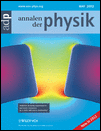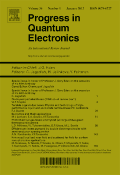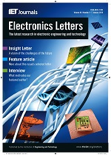
Radiophysics and Quantum Electronics
Scope & Guideline
Pioneering Research in Radiophysics and Quantum Realms
Introduction
Aims and Scopes
- Microwave and Terahertz Technologies:
Research related to the generation, manipulation, and application of microwave and terahertz radiation, including gyrotrons, masers, and waveguides. - Quantum Electronics and Photonics:
Studies focusing on the interaction of light with matter, including quantum optics, laser physics, and the development of advanced photonic devices. - Acoustic and Electromagnetic Wave Propagation:
Investigations into the dynamics and properties of wave propagation in various media, including studies on acoustic waves and electromagnetic fields. - Plasma Physics and Applications:
Research involving the behavior of plasmas, including diagnostics, interactions with electromagnetic fields, and applications in fusion and space physics. - Nonlinear Dynamics and Chaos Theory:
Exploration of nonlinear phenomena in wave systems, including chaos, solitons, and their applications in various physical contexts. - Environmental and Atmospheric Studies:
Application of radiophysics in understanding atmospheric phenomena, including studies on the influence of atmospheric conditions on wave propagation. - Biomedical Applications of Electromagnetic Waves:
Research focusing on the use of electromagnetic waves in medical diagnostics and treatments, including terahertz spectroscopy and microwave applications.
Trending and Emerging
- Advanced Quantum Technologies:
Research into quantum computing, quantum communication, and quantum sensing is gaining momentum, reflecting the broader trend towards harnessing quantum mechanics for practical applications. - Terahertz Applications and Technologies:
An increasing number of studies are focusing on terahertz radiation applications, particularly in biomedical imaging, spectroscopy, and communications, indicating a growing interest in this frequency range. - Nonlinear and Chaotic Systems:
An uptick in research on nonlinear dynamics and chaos theory is evident, with applications ranging from optics to plasma physics, highlighting the complex behaviors that arise in various systems. - Machine Learning in Signal Processing:
The integration of machine learning techniques in the analysis and processing of signals, particularly in radar and communication systems, represents a significant trend towards more intelligent and adaptive technologies. - Plasma Diagnostics and Control Techniques:
Emerging techniques for diagnosing and controlling plasma behavior are increasingly prominent, particularly in fusion research and space physics, reflecting advancements in experimental capabilities. - Environmental Monitoring Using Electromagnetic Methods:
Research applying electromagnetic techniques for environmental monitoring and atmospheric studies is on the rise, emphasizing the relevance of radiophysics to global challenges such as climate change.
Declining or Waning
- Traditional Radar Signal Processing:
Although radar technology remains crucial, the focus on conventional radar signal processing techniques appears to be diminishing in favor of more advanced methods involving machine learning and adaptive systems. - Static Electromagnetic Field Studies:
Research centered on static or quasi-static electromagnetic fields is becoming less frequent, possibly due to the growing interest in dynamic and time-varying field applications. - Basic Theoretical Models without Experimental Validation:
There seems to be a shift away from purely theoretical studies that lack experimental validation, as the journal increasingly favors research that includes practical applications and experimental results. - Low-Power Electromagnetic Devices:
Research on low-power applications of electromagnetic devices is becoming less common, reflecting a trend towards high-power and high-frequency technologies that promise greater efficiency and capability. - Classical Wave Phenomena:
Studies focused on classical wave phenomena without incorporating modern advancements in quantum mechanics or nonlinear dynamics are appearing less frequently.
Similar Journals

Journal of Electromagnetic Engineering and Science
Fostering Global Collaboration in Electromagnetic ResearchThe Journal of Electromagnetic Engineering and Science (ISSN: 2671-7255, E-ISSN: 2671-7263) is a premier Open Access journal published by the Korean Institute of Electromagnetic Engineering & Science. Since its establishment in 2001, it has been dedicated to advancing knowledge in the fields of Electrical Engineering, Electromagnetic Theory, and Communications, making significant contributions to both academia and industry. The journal holds an impressive Q2 quartile ranking in notable categories such as Computer Networks and Communications and Electrical and Electronic Engineering as of 2023, reflecting its robust scientific impact and reputation. It is indexed in Scopus, with commendable rankings in multiple fields, enhancing its visibility and reach among researchers. The journal's open-access model ensures that cutting-edge research is accessible to a global audience, fostering collaboration and innovation. Researchers, professionals, and students in the domain are encouraged to contribute and engage with high-quality articles that cover the latest advancements and trends in electromagnetic engineering and associated sciences.

ANNALEN DER PHYSIK
Connecting Scholars Through Groundbreaking ResearchANNALEN DER PHYSIK, a prestigious journal published by WILEY-V C H VERLAG GMBH, stands as a cornerstone of the field of physics and astronomy since its inception in 1799. With an ISSN of 0003-3804 and an E-ISSN of 1521-3889, this journal provides a platform for innovative research and critical discourse across various domains of physics. Annalen der Physik is currently ranked in the Q2 category for general physics and astronomy, occupying rank #76 out of 243 in Scopus, placing it within the 68th percentile. This indicates its significant impact and the quality of research it publishes. Although the journal does not offer Open Access options, its robust historical lineage and ongoing contributions ensure that it continues to be an essential resource for researchers, professionals, and students alike. For those seeking to stay at the forefront of contemporary physics research, ANNALEN DER PHYSIK represents a vital source of knowledge, innovation, and scholarly communication.

INTERNATIONAL JOURNAL OF MODERN PHYSICS A
Driving innovation in astronomy, atomic, and nuclear physics.INTERNATIONAL JOURNAL OF MODERN PHYSICS A, published by WORLD SCIENTIFIC PUBL CO PTE LTD, stands as a pivotal platform in advancing the frontiers of research within the fields of Astronomy and Astrophysics, Atomic and Molecular Physics, and Nuclear and High Energy Physics. Established in 1989, this journal has systematically contributed to the scientific community, with a demonstrated impact as indicated by its Q2 category rankings across these critical disciplines in 2023. Researchers and professionals are encouraged to engage with its rigorous peer-reviewed content, fostering a deeper understanding of modern physics theories and experimental breakthroughs. Although the journal operates under a conventional access model, it remains a vital resource for those seeking to disseminate their findings and stay abreast of cutting-edge developments. With an emphasis on quality and breadth of research, the journal continues to attract submissions from leading physicists and scholars, enhancing its reputation as a key academic resource.

Journal of Contemporary Physics-Armenian Academy of Sciences
Pioneering Research for a Dynamic Scientific Community.Journal of Contemporary Physics-Armenian Academy of Sciences is a distinguished publication dedicated to advancing the field of Physics and Astronomy. Published by PLEIADES PUBLISHING INC, this journal features cutting-edge research that addresses contemporary issues and developments within the realm of physics. With an ISSN of 1068-3372 and an E-ISSN of 1934-9378, the journal enjoys recognition within the academic community, currently holding a Q3 category quartile ranking in 2023, indicating its relevance and contribution to general physics and astronomy. Although the journal is not open access, it provides valuable insights and a platform for scholars and researchers to share their findings, thus promoting collaboration and innovation in the field. Based in the United States, at PLEIADES HOUSE, 7 W 54 ST, NEW YORK, NY 10019, the Journal of Contemporary Physics serves as a vital resource for researchers, professionals, and students aiming to stay informed about the latest scientific advancements and theoretical explorations.

Atoms
Fostering collaboration through open-access atomic research.Atoms is a distinguished open-access journal published by MDPI since 2013, dedicated to the fields of Atomic and Molecular Physics, Condensed Matter Physics, and Nuclear and High Energy Physics. With its E-ISSN of 2218-2004, the journal is based in Switzerland and has rapidly established itself as a noteworthy platform for disseminating innovative research and developments in atomic-scale physics. As reflected in its 2023 Scopus ranking, Atoms holds a respectable position within its field, with quartile rankings in the third tier across all its main categories. The journal's commitment to open access fosters a broader reach and collaboration within the scientific community, making it an essential resource for researchers, professionals, and students alike. The ongoing convergence of trends and research from 2013 to 2024 highlights Atoms' role in advancing knowledge and facilitating dialogue in crucial areas of physics.

St Petersburg Polytechnic University Journal-Physics and Mathematics
Exploring New Frontiers in Physics and MathematicsSt Petersburg Polytechnic University Journal-Physics and Mathematics is a distinguished academic journal published by the Polytechnical University Publishing House, dedicated to advancing the fields of physics and mathematics. Established as an Open Access publication since 2013, this journal aims to facilitate the unrestricted dissemination of high-quality research, allowing global access to innovative findings and discussions. With its ISSN 2405-7223, the journal serves as a pivotal platform for researchers, professionals, and students keen on exploring the latest advancements and theoretical insights within these disciplines. The journal emphasizes rigorous peer-reviewed articles, promoting critical discourse and collaboration within the scientific community. By prioritizing open access, it enhances academic engagement and supports the ongoing development of knowledge crucial for addressing contemporary scientific challenges.

Physical Review Applied
Transforming Ideas into Practical SolutionsPhysical Review Applied is a prestigious journal published by the American Physical Society that serves as a vital platform for researchers in the field of applied physics. With an esteemed Q1 ranking in the Physics and Astronomy category and a commendable Scopus rank of #35 out of 243, this journal represents a significant milestone in disseminating cutting-edge research. Established in 2014, it focuses on the latest advancements and applications in various realms of physics, promoting interdisciplinary collaboration and innovation. Although not an open-access journal, Physical Review Applied offers a range of access options for readers and institutions, ensuring that high-impact research remains widely available. Researchers, professionals, and students alike will find this journal an essential resource for staying at the forefront of applied physics developments.

PROGRESS IN QUANTUM ELECTRONICS
Connecting Ideas in Quantum and Materials SciencePROGRESS IN QUANTUM ELECTRONICS, published by PERGAMON-ELSEVIER SCIENCE LTD, is a premier international journal that serves as a critical forum for the dissemination of high-quality research in the fields of atomic and molecular physics, electrical engineering, and materials science. With its esteemed Q1 category ranking in several disciplines, including Atomic and Molecular Physics, Electrical and Electronic Engineering, and Electronic, Optical and Magnetic Materials, this journal commands a high impact factor and is recognized for its rigorous peer-review process. Established in 1969 and evolving through various phases, the journal currently compiles cutting-edge research that drives advancements in quantum technologies. Researchers, professionals, and students alike are invited to explore a wealth of knowledge and stay updated on pioneering developments in quantum electronics, enhancing their understanding and contributing to the progression of this dynamic field.

ELECTRONICS LETTERS
Empowering Engineers with Cutting-Edge Insights.ELECTRONICS LETTERS, published by WILEY, is a leading peer-reviewed journal dedicated to the field of Electrical and Electronic Engineering. With a rich history dating back to 1965, this journal serves as a prominent platform for disseminating novel research and innovations in electronics, covering topics such as circuit design, telecommunications, and signal processing. In 2021, the journal transitioned to an Open Access format, ensuring that cutting-edge research is freely accessible to a global audience, thereby enhancing its impact and outreach. The journal currently holds a Q3 quartile ranking in its category, reflecting its solid position among its peers, and ranks #451 out of 797 in Scopus for Electrical and Electronic Engineering, placing it within the 43rd percentile. ELECTRONICS LETTERS is essential for researchers, professionals, and students looking to stay abreast of the latest developments and contribute to advancements in the field, fostering collaboration and knowledge sharing in a rapidly evolving landscape.

ANNALES HENRI POINCARE
Advancing the Frontiers of Theoretical and Applied PhysicsANNALES HENRI POINCARE is a prestigious journal published by Springer International Publishing AG, dedicated to advancing research in the fields of Mathematical Physics, Nuclear and High Energy Physics, and Statistical and Nonlinear Physics. With an impressive Q1 ranking in its respective categories as of 2023, this journal is recognized as a vital resource for academic researchers, professionals, and students engaged in frontier studies of theoretical and applied physics. The journal's commitment to high-quality peer-reviewed articles promotes significant contributions to the understanding of complex physical phenomena, making it essential reading for anyone seeking to stay abreast of developments in these dynamic fields. Additionally, ANNALES HENRI POINCARE offers open access options to enhance the visibility and accessibility of groundbreaking research, underscoring its role in fostering collaborative scientific inquiry and innovation. Since its inception in 2000, it has continually provided a platform for scholars worldwide to disseminate their findings and engage with the broader scientific community, thus establishing itself as a cornerstone of academic literature.